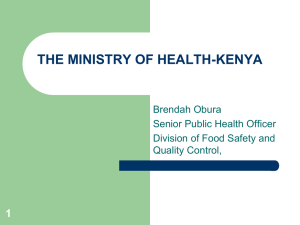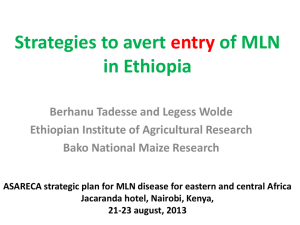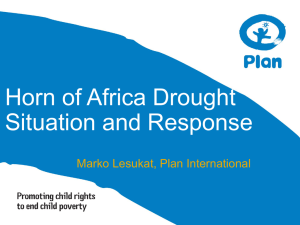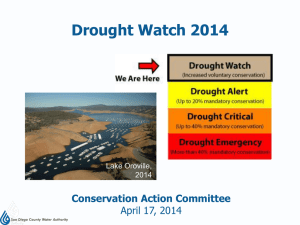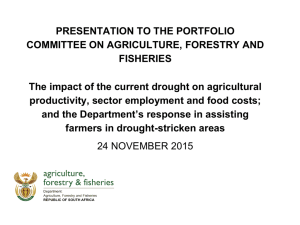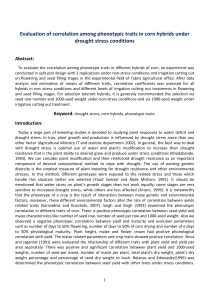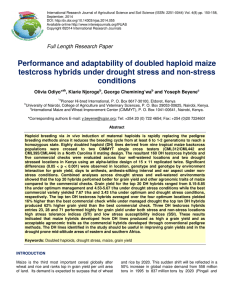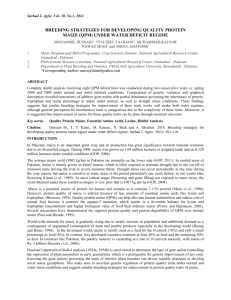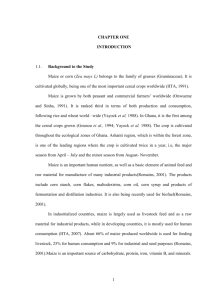Nyombaire.pmd - Makerere University News Portal
advertisement
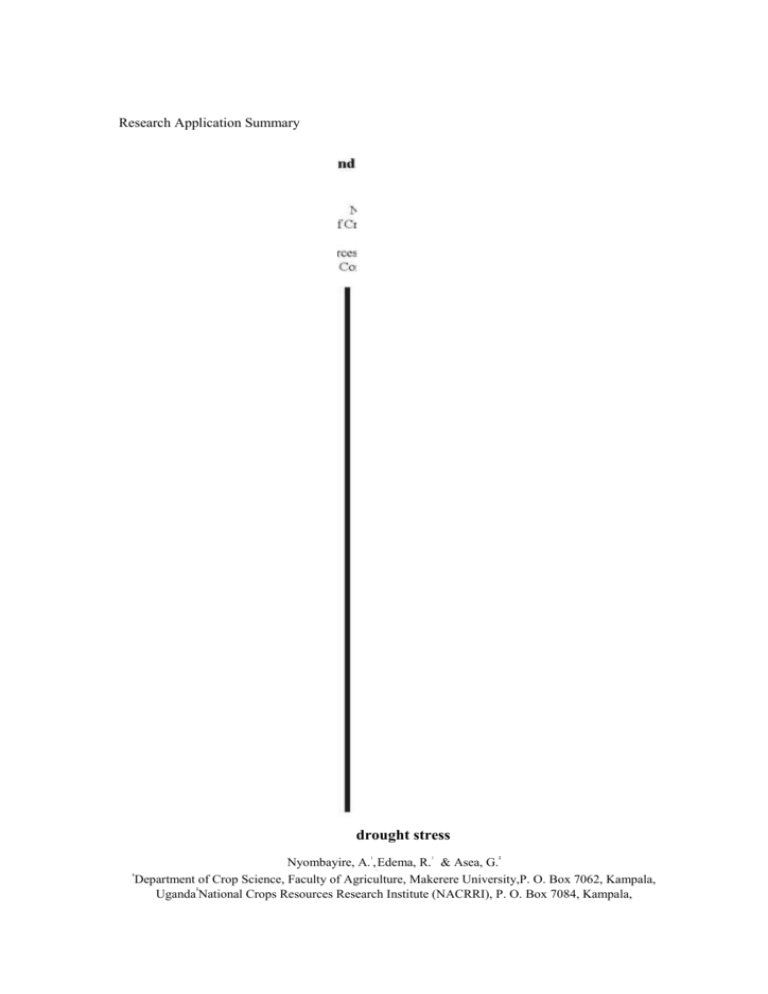
Research Application Summary drought stress 1 1 2 Nyombayire, A. , Edema, R. & Asea, G. Department of Crop Science, Faculty of Agriculture, Makerere University,P. O. Box 7062, Kampala, Uganda National Crops Resources Research Institute (NACRRI), P. O. Box 7084, Kampala, , 1 2 UgandaCorresponding author: nyombaip@yahoo.fr The main objective of this study was to develop maize genotypes that perform well under drought and low-nitrogen stresses. Twelve parents were crossed in a half-diallel mating design. The resultant F hybrids were evaluated in four environments; optimum N and low N, well-watered and drought-stressed environments. Also, the 12 parents and their resultant single cross hybrids were crossed with two elite testers, and the test crosses were evaluated under optimum and low N. The experimental design was an alpha-lattice with two replications. Across-site/environment analysis revealed variation among hybrids and environments, with both GCA and SCA effects significant. 1 Abstract Key words: Drought, half-diallel crosses, low-nitrogen stresses, maize Résumé L’objectif principal de cette étude était de développer les génotypes de maïs qui on une bonne performance sous des efforts de sécheresse et de faible azote. Douze parents ont été croisés dans une conception d’accouplement à moitié-diallèle. Les hybrides F résultants ont été évalués dans quatre environnements; celui de N optimal et de faible N, des environnements bien-arrosé et soumis à une contrainte de sécheresse. En outre, les 12 parents et leurs hybrides croisés simples résultants ont été croisés avec deux échantillons-test d’élite, et les croisements d’essai ont été évaluées sous N optimal et N faible. La conception expérimentale était un trellis-alpha avec deux répliques. L’analyse du site de travers/de l’environnement a indiqué la variation parmi les hybrides et les environnements, avec des effets significatifs de GCA et de SCA. 1 Mots clés: Sécheresse, croisements à moitié diallèle, effort à faible azote, maïs 515 Background Literature Summary Significant losses in maize yield resulting from drought are expected to worsen with local environmental degradation and global climate change in key traditional areas of its production in sub-Saharan Africa, home to some of the most vulnerable people groups. This is accompanied by limited maize production in much of the tropics due to an inadequate supply of nitrogen because inorganic fertilizers are either unavailable or too costly. Low N conditions and drought are considered the most important environmental factors affecting the stability of maize yield, which is also influenced by the capacity of the existing maize genotypes to respond to environmental conditions. Adequate levels of soil moisture and nitrogen are key to securing high yields. However, less than 7% of the agricultural area in sub-Saharan Africa is irrigated, and most farmers cannot afford or have no access to either organic or inorganic fertilizers in sufficient quantities (Banziger and Diallo, 2001; Meseka., et al., 2008). Though the difficulty of effectively selecting maize for low-N and drought environments has hampered breeding efforts, its productivity could be considerably improved with genotypes that can more efficiently use limited nitrogen and tolerate occasional periods of drought. Thus, the objective of this study was to evaluate performance of maize crosses under drought and low nitrogen conditions. In the tropics, drought and low soil fertility (especially nitrogen deficiency) frequently occur in association (Lafitte and Edmeades, 1994a). Precipitation is variable and unpredictable. Consequently, no season is “average” and a promising maize genotype must be able to withstand some variation in rainfall from year to year (Banziger et al., 2000). A significant proportion of all maize in the tropics is produced under low-N conditions. Many small holder farmers either do not gain sufficient return from N use to justify its cost, or they cannot afford or access it (Bänziger and Lafitte, 1997, Joseph et al., 2001; Meseka et al., 2006). Lafitte and Edmeades (1994a) suggested that a reasonable strategy for breeding productive maize under N-limited conditions would be to develop early- and late-maturing populations that under a limited N are still able to take up large quantities of N, partition a large proportion of plant N to the reproductive structures and maintain a high N concentration in the grain. However, information on the relationship between inbred lines selected for drought tolerance and the performance 516 Study Description Findings of their hybrids under low N would aid the development of effective breeding strategies for improving genotypes targeted for low-N and drought-prone environments (Zambezi and Mwambula, 1997). Twelve inbred lines of tropical origin were used in this study, seven tolerant to drought and five drought-susceptible. Half-diallel crosses were made between the twelve parents in 2008A. The resulting F ’s were evaluated in four mid-altitude environments during the 2008B-09B seasons: optimum N, low N at Namulonge, and well watered and drought-stressed at Kiboko, Kenya. Also, the 12 parents and their 53 single cross hybrids were crossed with two elite testers. The two resulting sets of test-crosses were evaluated separately in the second season under optimum and low N. All experiments were laid out in an alpha-lattice design, with two replications. 1 A drought-stressed environment was achieved by growing the crop in a rain-free period and withholding water from 2 weeks before anthesis, with only one subsequent irrigation at mid-grain fill to allow developing kernels and ears to complete their development. In contrast, the well-watered environment was irrigated every 3 days to field capacity until the end of the crop’s lifecycle. Low nitrogen experiments were grown in a field that has been depleted of N by 20 years of continuous high density cropping of maize or sorghum, without application of N fertilizer. Low-N status was confirmed by soil analysis. Measurements for the important quantitative and qualitative agronomic traits were recorded on a plot basis. Genotypes and imposed environments were considered fixed effects, while seasons, replications and blocks within reps were considered random effects. Lattice-adjusted means were used to estimate general combining ability (GCA) and specific combining ability (SCA) effects ,for the half-diallel experiment, based on Griffing’s Diallel Method 4 and Model I (Griffing, 1956). The testcrosses were analyzed as a two-way mating, and the results correlated with the corresponding single-crosses from the half-diallel mating. Combined analysis of variance across all environments showed highly significant differences (p<0.001) among environments, hybrids, and environments x hybrids GCA, SCA, and their interactions with environments also showed highly significant differences (p<0.001). Hence, additive and non-additive effects Table 1. 517 Analysis of variance at each environment and across environments for grain yield (t/ha). Sources Df OPN LN WW MD Across Environments Mean squares Df Mean squares Env ----3 496.140*** Crosses 52 0.617* 0.250 ns 3.974*** 0.497** 52 1.880*** GCA 11 0.761 + 0.408 ns 5.521*** 0.912*** 11 5.430*** SCA 41 0.578 * 0.207 ns 3.560*** 0.386* 41 0.930**** Envxcrosses ----156 1.150*** GCA xEnv ----33 2.820*** SCA xEnv ----123 0.700*** Error -0.355 0.247 0.852 0.201 158 0.416 Mean 5.3 1.9 7.8 1.1 4.0 + ,*, **, *** indicates significance at 0.1, 0.05, 0.01, and 0.001 probability levels, respectively. ENV = Environments; ns = no significance (p>0.05); OPN = Optimum nitrogen; LN = Low nitrogen; WW = Well-watered; MD = Managed drought. and their interactions with environments were all important (Table 1). Within-environment analysis showed significant differences among crosses and in GCA and SCA for each environment except for under the low N environment (Table 1). Recommendation Since this study focused mainly on phenotypic aspects, it is recommended that a molecular study be carried out to confirm these findings. Acknowledgement This work was feasible by the joint collaboration of the Alliance for a Green Revolution in Africa (AGRA), Rwanda Agricultural Research Institute (ISAR), Makerere University and RUFORUM (Regional Universities Forum). The contribution of each is highly appreciated. References Bänziger, M., Edmeades, G.O., Beck, D. and Bellon, M. 2000. Breeding for drought and nitrogen stress tolerance in maize: From theory to practice. Mexico, D.F. CIMMYT. Lafitte, H.R. and Edmeades, G.O. 1994a. Improvement for tolerance to low soil nitrogen in tropical maize. I. Selection criteria. Field Crops Research 39:1-14. 518



